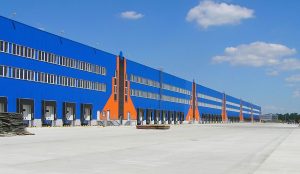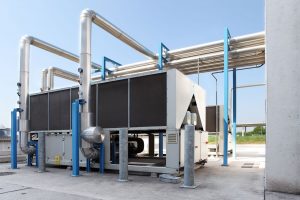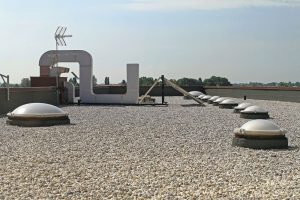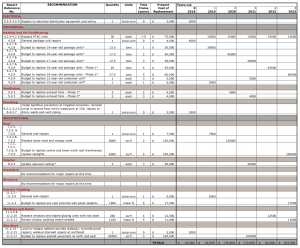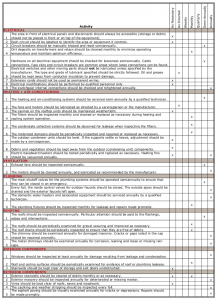
Maintenance, Repairs, and Capital Replacement Plans for Industrial Buildings
If you are an investor that owns and manages an industrial building or a portfolio of industrial buildings, then you will know that how you deal with the regular ongoing building maintenance, repairs and replacements of capital items can make a huge difference to your bottom line, as well as your tenant’s satisfaction.
In my experience, most of the large property owners with systems and teams of “in-house” or external managers and advisors in place; from maintenance and legal to property and asset management, have everything, or most of it covered. However, many small- and mid-size Investors have lots of room for improvement.
In many cases, these Investors are leaving money on the table and are not fully maximizing their return on investment.
And when I say “regular repairs, maintenance and capital replacements of capital items,” what we are referring to is the repair and maintenance of the roof membrane, HVAC and mechanical systems, and asphalt.
So what I would suggest is to put in place a plan that will allow you to efficiently manage, maintain, repair and replace the property including capital items so that you can maximize your return and preserve the value of your investment; while providing tenants with an ongoing, worry- and crisis-free, quiet enjoyment of the premises.
How to Maximize and Preserve the Value of Your Investment – Process
The first step would be to conduct a Property Condition Assessment which will include the overall condition and level of maintenance of the property, including the:
- structure,
- exterior components of the building,
- interior components, and
- at minimum, provide a Five Year Summary of Recommendations for repairs and replacements.
Maintenance, Repairs and Capital Replacement Plan
Such a plan would help you organize information about the physical condition of the property and any long-term financial needs.
Collecting information on the current condition of the building and its equipment forms the basis of your plan, and is crucial in predicting future potential repairs and replacements. In addition, current replacement costs and assumptions about future inflation would be factored into the estimates.
A Replacement Schedule would show future repairs and capital replacement needs, as well as how much money you must put aside to carry out the replacements.
How to Maximize and Preserve the Value of Your Investment – Planning Steps
There are a few basic steps in creating a Maintenance, Repairs and Capital Replacement Plan. Below is a short summary…..
Step 1: Collect information on the current physical condition of your property.
Step 2: Predict the future needs of your property by preparing a Replacement Schedule and Cash Flow Forecast based on the information previously collected.
Step 1 – Collecting Information
A Maintenance, Repair and Capital Replacement Plan needs accurate and up-to-date information. The up-front effort you invest in collecting information will pay off for many years. You can collect this information from a detailed physical inspection of the property and from previous management records.
Prepare a Building Inventory
Before creating the Repairs and Replacement Schedule, you or your consultant should prepare a list of all the replacement items in your property. The Building Inventory should contain a complete list of the systems, components, and equipment that may need repairs or replacements in the future.
Assess Useful Life
Assessing “Useful Life” calls for an assessment of when and how often replacements are made. The normal and actual service life of major components are two of the most important pieces of information in a Capital Replacement Plan. For each item, you need to know:
- the remaining useful life – when the next replacement will occur, and
- the normal useful life – how often future replacements will be necessary.
The normal useful life of each item is based on industry standards (for example, HVAC System – 15 years, Roof Membrane – 25 years), but there are other factors that can affect the “normal useful life” of your property.
A component’s “effective age” is the basis of the remaining useful life. The “effective age” means that the component is better or worse than its age suggests. For example, the normal “age” to replace the roof membrane may be in the range of 20 – 25 years. However, with good preventive maintenance and care, it may not need replacement for 25 – 30 years.
Some of the conditions that may result in a reduction in useful life are:
- poor-quality construction methods,
- low-quality materials,
- inadequate maintenance,
- microclimate conditions that increase wear, such as freeze-thaw cycles, local humidity levels, etc.
- higher than normal wear and tear, such as from many heavy trucks on the asphalt,
- many roof penetrations for equipment.
Cooling System
Property Condition Assessment Report
A Property Condition Assessment Report can help you assess the remaining useful life of building components. The report contains information about immediate or possible problems with the condition of your property and any repairs to deferred maintenance required. A qualified engineer could conduct a property inspection and prepare the report with observations and recommendations.
The Property Condition Assessment Report should generally conform with the ASTM Standard E2018-15 and include:
- an inventory of all the property’s systems, components, and equipment,
- observations about problems related to building safety, structural integrity, and building function,
- consultant’s insights on the cause of each problem and recommendations for follow-up,
- estimates for normal life and remaining life,
- advice on preventative maintenance routines and other steps to prolong the useful life of items,
- recommendations for any additional study or testing that is useful, and
- priority lists and cost estimates for the replacements, especially those needed in the next three to five years.
The actual condition of your property forms the basis of these estimates. The assessment provides useful life estimates and develops priorities for future replacements. The survey is especially useful in preparing a regular ongoing Maintenance, Repairs and Capital Replacement Plan for the first time.
This report will be very useful if and when you decide to refinance or sell the property. In addition, you may also ask the consultant or inspector to provide:
Estimates on Repairs and Replacement Costs
At this stage of planning, you should estimate the cost of making repairs or replacements by talking to contractors and suppliers or by hiring a consultant. You are not looking for formal quotes or firm bids now (something you will receive when making a replacement), but rather beginning to collect information.
Flat Industrial Roof
Step 2 – Predicting & Forecasting Future Needs
When you have a complete picture of the current condition of your property, you are ready to look ahead. In this step, you will need to make calculations, prepare forecasts, and identify potential risks.
Maintenance, Repairs, and Replacement Schedule
The Replacement Schedule is a timeline showing the replacements for each year. The illustration below shows one approach in setting up a Replacement Schedule using a spreadsheet.
Recommended Repairs & Replacements – 5-year Schedule Source: CDW Engineering
Above is a sample chart from one of our successfully completed projects. It shows a regular ongoing maintenance schedule, as well as capital replacements over a period of five years. The most expensive items are obviously the Heating and Air-Conditioning units, roof membrane, and asphalt.
When reviewing the components and systems, the following terms are usually used to describe their condition:
- Satisfactory – Performing its intended function; no major defects noted.
- Serviceable – Performing its intended function but has visible defects or is aging. It will require minor to moderate repairs.
- Fair – Barely performing its intended function. Has visible defects or is aging and will require moderate to major repairs in the short term.
- Poor – Not properly performing its intended function. At or beyond its useful life. The component requires major repair or replacement.
How to Maximize and Preserve the Value of Your Investment – Putting It To Work
Adopting and using a Maintenance, Repairs and Capital Replacement Plan is an important step in managing your property. This plan will enable you to make great management decisions. While you are preparing a plan, you should put together useful information about your building in order to understand it better.
Benefits of The Plan – It will:
- alert you to hidden building problems,
- help to point out maintenance priorities,
- help you decide when to repair or when to replace,
- assist in making purchasing decisions (which items, quantity, and timing), and
- help you examine your investment decisions.
You may decide to invest and continue to own the property or you may decide to sell the property prior to having to conduct some major repairs and replacements.
Maintenance Recommendations Example – Source CDW Engineering
So, now that you have completed a Property Condition Assessment Report and have put in place a Repairs, Maintenance and Capital Replacements Plan, how are you going to ensure that the cost of regular maintenance, repairs, and capital replacements is recovered from your tenants?
And how will you ensure you maximize your returns and preserve the value of your investment?
Should you establish a “sink fund” and, following the occupancy date, start collecting the annual amortized cost for the replacement of major building components (like the aforementioned roof membrane, HVAC Systems and asphalt)… so that when the time comes for said replacements you actually have the funds to do so?
Well, we will talk about that in our next article….
We will also dive deeper into each one of these major building components to help you better understand the different types of roof membranes, HVAC systems, and asphalt, useful life, the cost to conduct regular maintenance and replacements… as well as how to address all of these in a Lease Agreement…
Until next week…
Goran Brelih and his team have been servicing Investors and Occupiers of Industrial properties in Toronto Central and Toronto North markets for the past 25 years.
Goran Brelih is a Senior Vice President for Cushman & Wakefield ULC in the Greater Toronto Area.
Over the past 27 years, he has been involved in the lease or sale of approximately 25.7 million square feet of industrial space, valued in excess of $1.6 billion dollars while averaging between 40 and 50 transactions per year and achieving the highest level of sales, from the President’s Round Table to Top Ten in GTA and the National Top Ten.
Goran is currently serving as Immediate Past President of the SIOR ‐ Society of Industrial and Office Realtors, Central Canadian Chapter and on the Board of Directors of Muki Baum Accessibility Centre, a Toronto‐based NGO which provides support to children and adults with complex disabilities.
Specialties:
Industrial Real Estate Sales and Leasing, Investment Sales, Design-Build and Land Development
About Cushman & Wakefield ULC.
Cushman & Wakefield is a leading global real estate services firm that delivers exceptional value by putting ideas into action for real estate occupiers and owners. Cushman & Wakefield is among the largest real estate services firms with 48,000 employees in approximately 400 offices and 70 countries.
In 2017, the firm had revenue of $6.9 billion across core services of property, facilities and project management, leasing, capital markets, advisory, and other services. To learn more, visit www.cushmanwakefield.com or follow @CushWake on Twitter.
For more information on GTA Industrial Real Estate Market or to discuss how they can assist you with your real estate needs please contact Goran at 416-756-5456, email at goran.brelih@cushwake.com, or visit www.goranbrelih.com.

